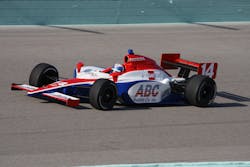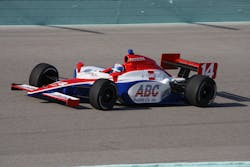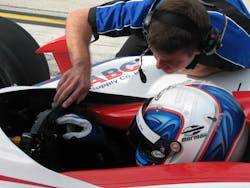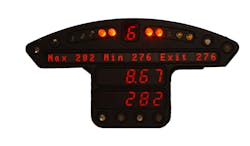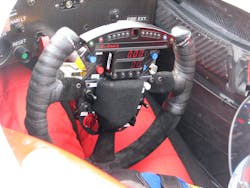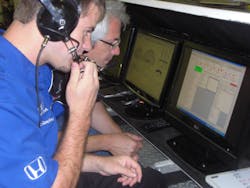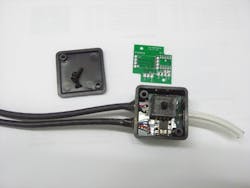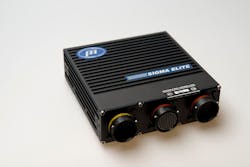Surely most racing fans have May 24, 2009, circled on their calendars. For the non-gearheads, this Memorial Day marks the 93rd running of the Indianapolis 500. The event will pit 33 cars and drivers against each other in a grueling 500-mile race around a 2.5-mile track. The fastest average speed is more than 185 mph with top speeds cresting at about 235 mph.
The front and back straightaways are only five-eighths of a mile long, so drivers spend a good deal of time in the 9° banked turns. Trying to drive the optimum path with 32 other cars on the track is a real challenge, since each driver wants to be on the optimum line.
The race is more impressive when you consider that it’s more of a test of drivers and their teams than the best open-wheel race car. There are always variances, but the Indy Racing League (IRL), known as IndyCar, sets the specifications for the cars, making them nearly identical (see “IndyCar Specifications”).
Teams do have a wider range of discretion when it comes to brakes, tires, and suspension, but even they have some strict limits. However, teams can augment the sensor and telemetry system used in the car (Fig. 1). These modifications can often provide the edge that a team needs to win, whether it’s in selecting the best time to enter the pits or choosing what kind of tires to use.
Well, almost. There are strict limits on dimensions, weight, and all sorts of details such as the size and placement of the wings found on the front and rear of the cars. The engine and transmission/ gearbox are the same in each car. They can’t be tweaked, although they can be controlled. That means no playing around with the engine control unit (ECU).
Likewise, the RPMs are limited to 10,300. Go above the limit, and the engine will slow down by 9500 RPM, so there’s an incentive to push the limit but not exceed it. This can be tough when operating near the limit because bumps, wind, and drafting all affect the load on the engine and, hence, its speed.
It’s possible to make faster cars, but 225 mph is the turning point at which human reaction time turns a safe race into collision city. The cars are designed for safety, so drivers usually walk away from spectacular crashes, though fatal accidents have occurred at the Indianapolis Motor Speedway, also known as the Brickyard.
To reach this speed, the cars use a 650-hp, 3-l Honda V8 engine that costs about $2.9 million per car. The engine is smaller than the 3.5-l engine used a few years ago, and its smaller power band forces drivers to shift more often. The engines are designed to last at least 1200 miles between rebuilds, but this is definitely not stop-and-go traffic.
The engines run on 100% ethanol. The designers looked to minimize engine failures under demanding race loads while also cutting operating costs. A new engine will come into play next year. Thus, several additional suppliers are considering support for IndyCar.
SEMI-AUTOMATIC TRANSMISSIONAdam Schaechter, chief engineer at AJ Foyt Racing, says that one of the biggest changes in the race over the past few years has been the switch to the current six-speed, all-forward-gears, semi-automatic transmission. It eliminates the clutch pedal and provides electronic control to synchronize timing and torque requirements, resulting in a smooth, efficient transition.
The drivers only have to contend with a paddle shifter that toggles up or down one gear. The shift control incorporates strain gauges to determine when a driver desires a transition. This has led to a “shift without lift” approach to driving, where the driver always has the “pedal to the metal.”
During a transition, the ECU will interrupt the fuel flow and ignition to the engine, providing a smoother shift. All of this accounts for the current speed and load on the engine. The transition occurs in 30 to 60 ms. The parameters are adjustable, but they’re set by IndyCar, not the teams.
The clutchless, semi-automatic transmission meshes with the IndyCar requirements because drivers would normally shift up and down. Jumping over gears is not a good idea. Over-revving an engine due to improper shifting can cost tens of thousands of dollars in wear and tear.
The semi-automatic transmission is relatively new for IndyCar, but so far it’s been well received. It tends to narrow the gap between drivers because manual shifting is an art, especially when moving at over 200 mph. The new transmission makes it easier to shift more if warranted. The shift paddles are mounted on the steering wheel for easy access.
The team can’t adjust the shifting mechanism and parameters, but it can modify the gear ratios. Changing the ratios takes five to 10 minutes. Teams often change them during practice sessions (but almost never during a race) to determine the optimal combination for a particular session, since everything such as humidity and temperature can affect how a car will handle. Selecting the right gear ratio is one way to improve a team’s chances of winning.
WHEEL WATCHINGThe IndyCar’s cramped interior is rather spartan, so simple and easy-to-read outputs are the norm (Fig. 2). In terms of complexity, the output is at the opposite end of the spectrum compared to a heads-up display in a fighter cockpit. It’s even simpler than the typical automobile.
Whereas a fighter pilot must analyze lots of data like positional threat information, an IndyCar driver wants minimal information and minimal distraction. Positional information is immediate and visual, including the track, the walls, and the other cars. Almost everything else is secondary.
Custom steering wheels do not necessarily mean complete customization. Many teams use steering wheel dashboards from companies like Pi Research. Its Pi Sigma Dash is easily incorporated into a custom wheel design (Fig. 3).
AJ Foyt Racing designed its steering wheel for its driver, Victor Meira (Fig. 4). Key controls are just inches away from gloved hands for easy access. The numeric displays provide basic details such as the current gear, while the longer but small display provides more detailed text messages for status or error conditions.
The text areas can display lap time, current or average speed, oil and water temperature, and the amount of fuel left in the tank. One bank of LEDs across the top of the steering wheel provides shift feedback. A full row of all-on LEDs indicates when it’s time to shift gears, just a paddle toggle away. It would be easy to display the engine RPM, but a row of LEDs makes for an easier to read meter, especially when the idea is to stay under the max RPM.
Two other dial adjustments on the wheel control the fuel mix and the suspension. The fuel mix helps control consumption and affects when cars need to pit. Telemetry information about fuel consumption and the amount of fuel onboard allows real-time feedback to the pit crew regarding when a car will have to stop in the pits to refuel.
The suspension control, or weight jacker, adjusts the setting of the cross weight pump connected to the hydraulic system. It adjusts the stiffness of the right rear shock, which in turn adjusts the pressure on the wheels. This is a dynamic adjustment the driver can make compared to the front and rear wings, which also affect weight distribution. The front wing can be quickly modified when the car comes into the pit using a simple adjustment.
Ron Ruzewski, technical director and race engineer #3 for Team Penske Dallara/ Honda, notes that each driver on the team has a backup steering wheel. Drivers also take their wheel with them when they drive a different car. Swapping a wheel is simple since there’s a common connector for the control and status information and a standard wheel mount.
These steering wheels are a bit more expensive than the typical steering wheel, even those with multiple controls found on high-end consumer vehicles. The wheels are custom-made, so backups are critical. Without them, a driver may have to work with unfamiliar equipment—not a good option in an environment where split-second operations are common.
OVER-THE-SHOULDER TELEMETRY The pit crew gets its hands on the car occasionally, but the tech crew monitors the car continuously during a race or a practice run. The telemetry information from a single car has real-time data from dozens of sensors, but only a subset will likely be monitored at one time from a handful of PC screens.Adam Schaechter and one or two coworkers typically monitor this information during a race (Fig. 5). Everyone keeps an overall eye on the telemetry information, and even the pit crew will take a gander at the screens to get a general feel for how the car is performing. The crew in front of the displays keeps an eye out for trends or problems and provides feedback to the pit and the person communicating with the driver. The driver is the focal point and shouldn’t be distracted by a host of backseat drivers.
The software used to display the telemetry is normally custom and is designed to highlight trends in addition to providing alerts when thresholds are exceeded. The driver automatically sees these alerts if they’re very serious and might require immediate action. Typically, though, the tech pit crew takes these readings into account when providing recommendations to the driver and the pit crew.
For example, tires are a critical component that are often changed multiple times during a race. In the pits, changing a set of tires takes as little as six seconds. The type of tire and even the tire pressure for a replacement set are selections made well in advance of the car coming off the track.
Continued on page 3
The choice hinges on a range of factors, such as the tire characteristics; track characteristics, including details like temperature; and the data available from the car via telemetry. The experience of the team is, no doubt, also crucial.
In addition, it’s possible to detect a leak in a tire by watching its pressure. Detecting a leak early allows a car to return to the pit early for a quick replacement before the tire goes flat. Another area of adjustment is the cooling system. If the car and engine are running too cold or hot, then changes need to be made the next time the car comes into the pits.
Other members of the crew will often take a quick look at the readings in addition to the full-time tech crew. The telemetry information is distributed by a localarea network (LAN), so it’s easy to add more workstations to the mix.
Ron Ruzewski notes that teams with multiple cars, such as Penske, will normally have a dedicated crew for each car while using a common network. This makes it possible for one crew to view the information about the other car, which can be handy for seeing how track conditions are affecting the other vehicles.
BUILD YOUR OWN SENSORSMany sensors are already built into the system, such as the ECU. Much of this information is available via the controllerarea network (CAN) bus that’s already used to link automotive control and monitoring systems. Likewise, sensors are built into components throughout the car, such as tire pressure and temperature sensors. These sensors are now making their way into consumer automotive products, too.
Teams can add more sensors to complement those already built into the car. Many of these devices are off-the-shelf sensors with standard interfaces such as serial or CAN. For others, more custom work is involved.
Teams occasionally design and build their own sensors (Fig. 6). This involves a custom circuit board using off-the-shelf sensors from distributors like Digi-Key. They’re easily hooked into the telemetry system using microcontrollers. Schaechter indicated that the increased availability of sophisticated low-cost sensors with digital interfaces has greatly simplified the job of creating these modules. In fact, modules are often created in-house now instead of being farmed out to a consulting firm.
These custom modules must be ruggedized to handle race conditions. Some are used only during practice, while others may be used during a race. They can be used for diagnostics to help isolate problems as well.
SAFETY FIRST, DATA SECONDKeeping the driver safe is paramount, which sometimes means reducing the performance of the cars across the board. It’s why engines have been scaled down over the years—increased efficiency has led to higher-performance engines. Still, there are occasional fender benders and major crashes. This is where the little IRL black box comes into play.
Similar to the black box on airplanes, it’s designed to survive a crash and record sensor information during the race. Over the years, the black-box design has benefited from improved electronics. This includes more sophisticated sensors like the g-force sensor that’s part of the earphone drivers use for communication.
Such information is handy in recreating a crash, but it can also be useful to medical personnel who are helping the driver after a severe collision. Likewise, improvements in storage allow more information to be recorded, providing more accurate crash reconstruction after the fact.
Electronics, especially video, are apparent to those watching the race on television. The in-car views provided by tiny cameras are given to teams for races, but the teams have to pay for the footage if they want access to the feed.
These cameras are extremely small and light, so including more than one is easy. On occasion, a team may also rent a system for diagnostic purposes to target a specific area on a car, such as a troublesome component. Even thermal imaging will come into play if it can help solve a problem. There’s also a pair of high-speed cameras at the finish line for those photo finishes.
The pit is under camera coverage as well. This video is normally examined after a race to see where problems may have occurred or to help the pit crew optimize how it services the car.
BEFORE AND AFTER THE RACEOver the years, significant change has occurred in pre-race design and practicerun analysis as well as post-race analysis. Applications developed using tools such as SolidWork, Matlab, and LabVIEW are being used to a team’s advantage.
These applications tend to be very customized, and teams prefer to keep the applications and the information gleaned a secret, as they can help provide the edge in winning the next race. Modeling and simulation help teams optimize the areas they can change, such as the suspension, springs, and tires. Drivers are pushing their cars to the edge, and this type of modeling can highlight limitations and what happens when ambitions meet chemistry and physics.
Off the shelf logging units like Pi Research’s Pi Sigma are designed for race cars (Fig. 7). Sealed boxes with conduction cooling and locking plugs will be familiar to anyone dealing with rugged environments. It is matched with analysis software tools like Pi Toolbox.
About the Author
William G. Wong
Senior Content Director - Electronic Design and Microwaves & RF
I am Editor of Electronic Design focusing on embedded, software, and systems. As Senior Content Director, I also manage Microwaves & RF and I work with a great team of editors to provide engineers, programmers, developers and technical managers with interesting and useful articles and videos on a regular basis. Check out our free newsletters to see the latest content.
You can send press releases for new products for possible coverage on the website. I am also interested in receiving contributed articles for publishing on our website. Use our template and send to me along with a signed release form.
Check out my blog, AltEmbedded on Electronic Design, as well as his latest articles on this site that are listed below.
You can visit my social media via these links:
- AltEmbedded on Electronic Design
- Bill Wong on Facebook
- @AltEmbedded on Twitter
- Bill Wong on LinkedIn
I earned a Bachelor of Electrical Engineering at the Georgia Institute of Technology and a Masters in Computer Science from Rutgers University. I still do a bit of programming using everything from C and C++ to Rust and Ada/SPARK. I do a bit of PHP programming for Drupal websites. I have posted a few Drupal modules.
I still get a hand on software and electronic hardware. Some of this can be found on our Kit Close-Up video series. You can also see me on many of our TechXchange Talk videos. I am interested in a range of projects from robotics to artificial intelligence.
